
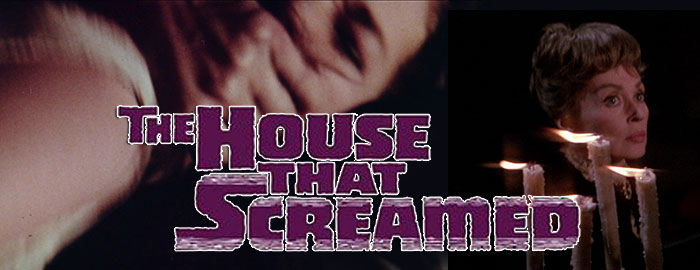
Color, 1969, 105 mins. 11 secs. / 94 mins. 22 secs.
Directed by Narciso Ibáñez Serrador
Starring Lilli Palmer, Cristina Galbó, John Moulder-Brown, Mary Maude, Maribel Martin
Arrow Video (Blu-ray) (US/UK RA/RB HD), Scream Factory (Blu-ray) (US RA HD),
Alive (Blu-ray & DVD) (Germany RB/R2 HD/PAL), Divisa (Spain R0 PAL) / WS (2.35:1)
At the same time Italian audiences 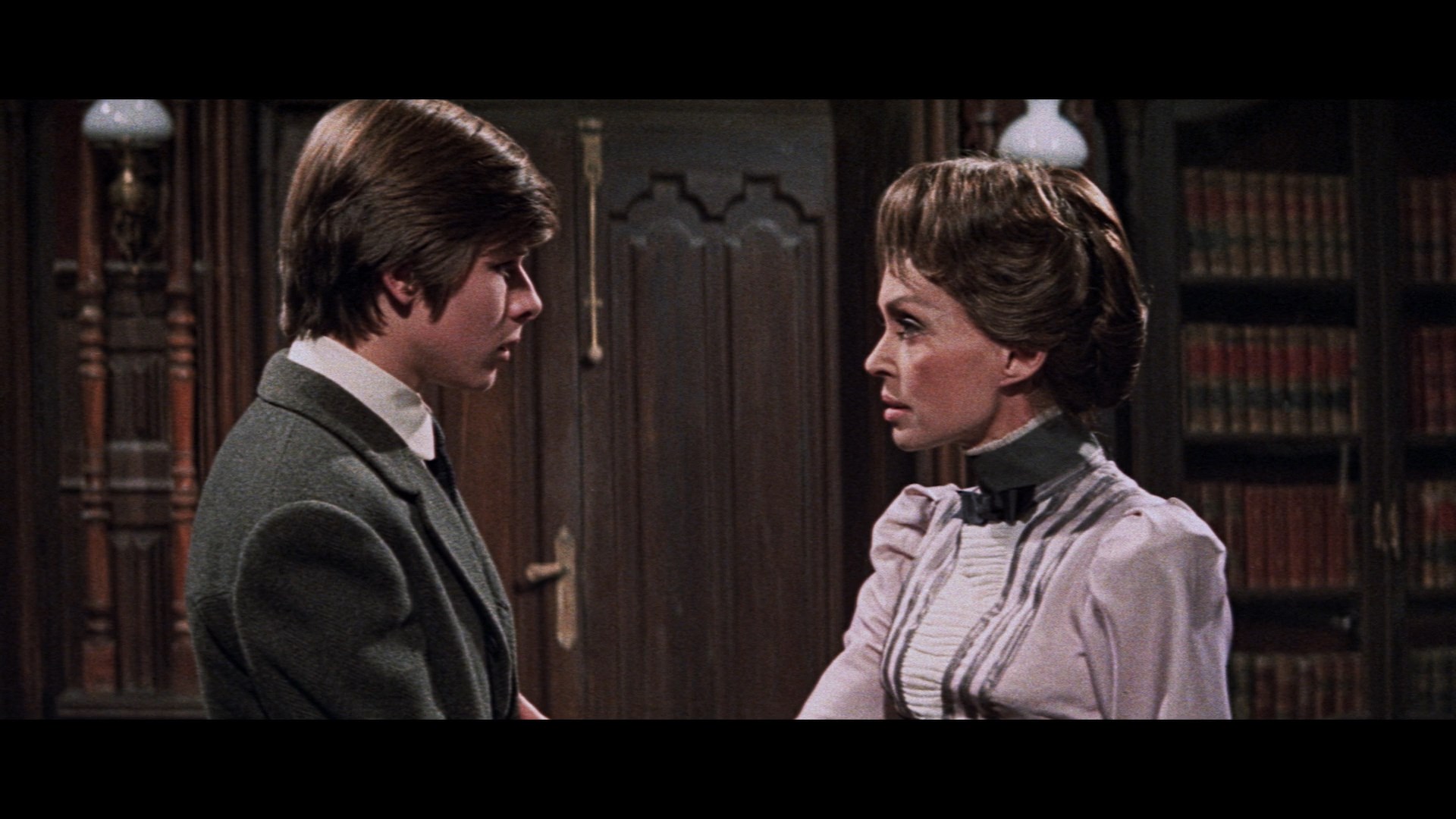 saw the revitalization of the giallo courtesy of Dario Argento's first
saw the revitalization of the giallo courtesy of Dario Argento's first 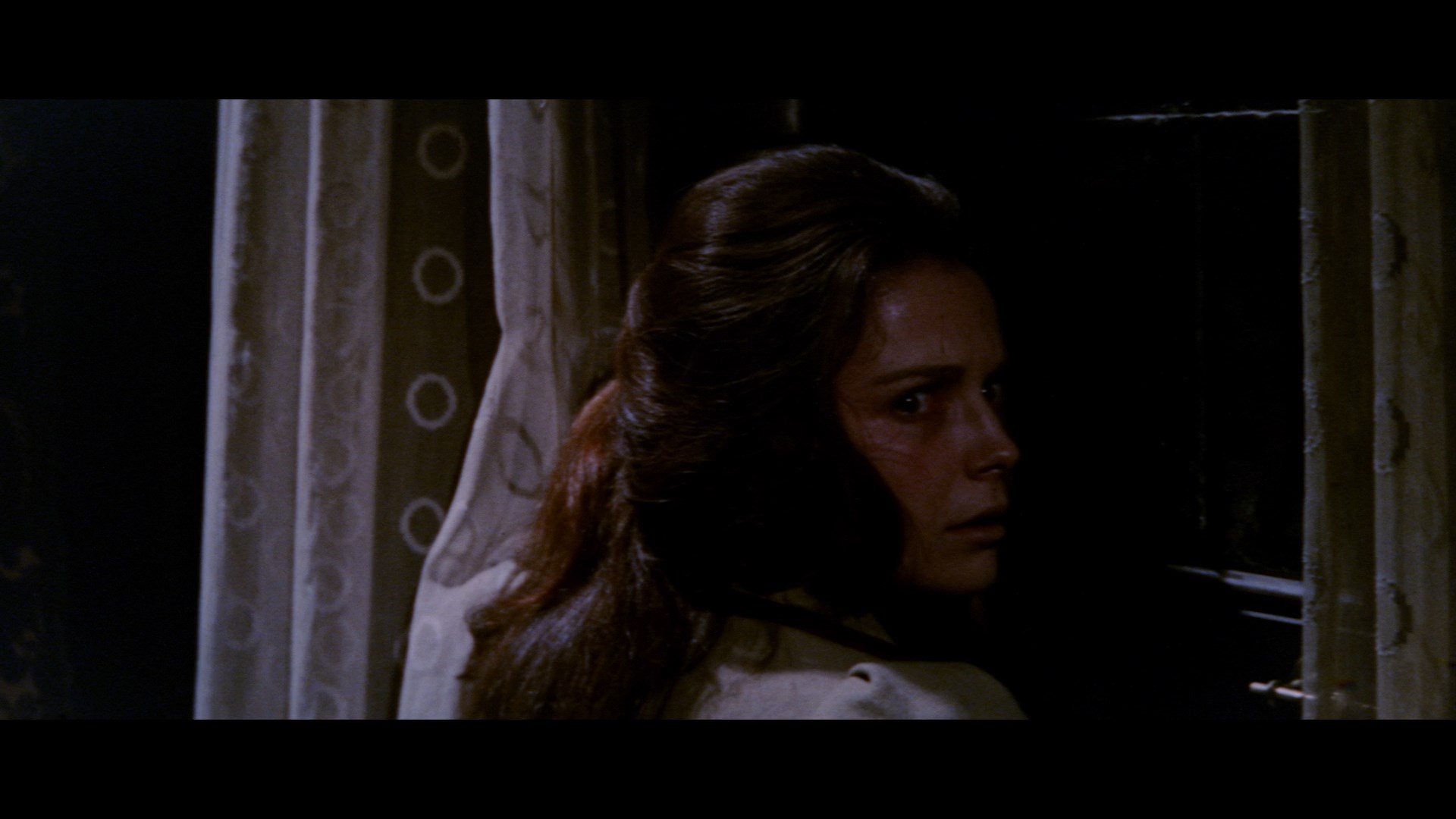 film, The Bird with the Crystal Plumage, Spain was jumping into the game with its own Gothic twist on the same themes, Narciso "Chicho" Ibáñez Serrador's La residencia, a film that would in turn be cited as a major influence on Argento's Suspiria. Both films received notable wide releases abroad (edited down to receive lenient GP ratings in America), but Serrador, already famous in Spain for his ongoing TV series Tales to Keep You Awake, only returned to the genre once more with the excellent Quién puede matar a un niño? (Who Can Kill a Child?), released by AIP as Island of the Damned.
film, The Bird with the Crystal Plumage, Spain was jumping into the game with its own Gothic twist on the same themes, Narciso "Chicho" Ibáñez Serrador's La residencia, a film that would in turn be cited as a major influence on Argento's Suspiria. Both films received notable wide releases abroad (edited down to receive lenient GP ratings in America), but Serrador, already famous in Spain for his ongoing TV series Tales to Keep You Awake, only returned to the genre once more with the excellent Quién puede matar a un niño? (Who Can Kill a Child?), released by AIP as Island of the Damned.
Young Theresa (The Living Dead at Manchester Morgue's Cristina Galbó) arrives at a remote, sprawling finishing school for girls run by the stern Madame Fourneau (stage and screen vet Lilli Palmer), and tentatively begins a friendship with Fourneau's voyeuristic son, Luis (Deep End's John Moulder-Brown). Unfortunately disobedient girls tend to get locked away in a large storage closet and whipped by Forneau's right hand girl, Irene (Terror's Mary Maude). One night a student slips out to the nearby greenhouse, and a chain of murder and intrigue begins...
Leisurely paced by drive-in standards at the time, The House That Screamed indulges in an entire first act of character development, flagellation, shower room sexual tension, and peeping tom antics before the knife-wielding killer finally makes an appearance in one of the most startling pre-slasher killings of Euro cinema. The expert scope photography makes marvelous use  of the baroque settings, often filing the girls across the screen with each one's expression perfectly conveying where she lies in the academic food chain. Several critics, most notably Phil Hardy's Aurum Encyclopedia, charged
of the baroque settings, often filing the girls across the screen with each one's expression perfectly conveying where she lies in the academic food chain. Several critics, most notably Phil Hardy's Aurum Encyclopedia, charged 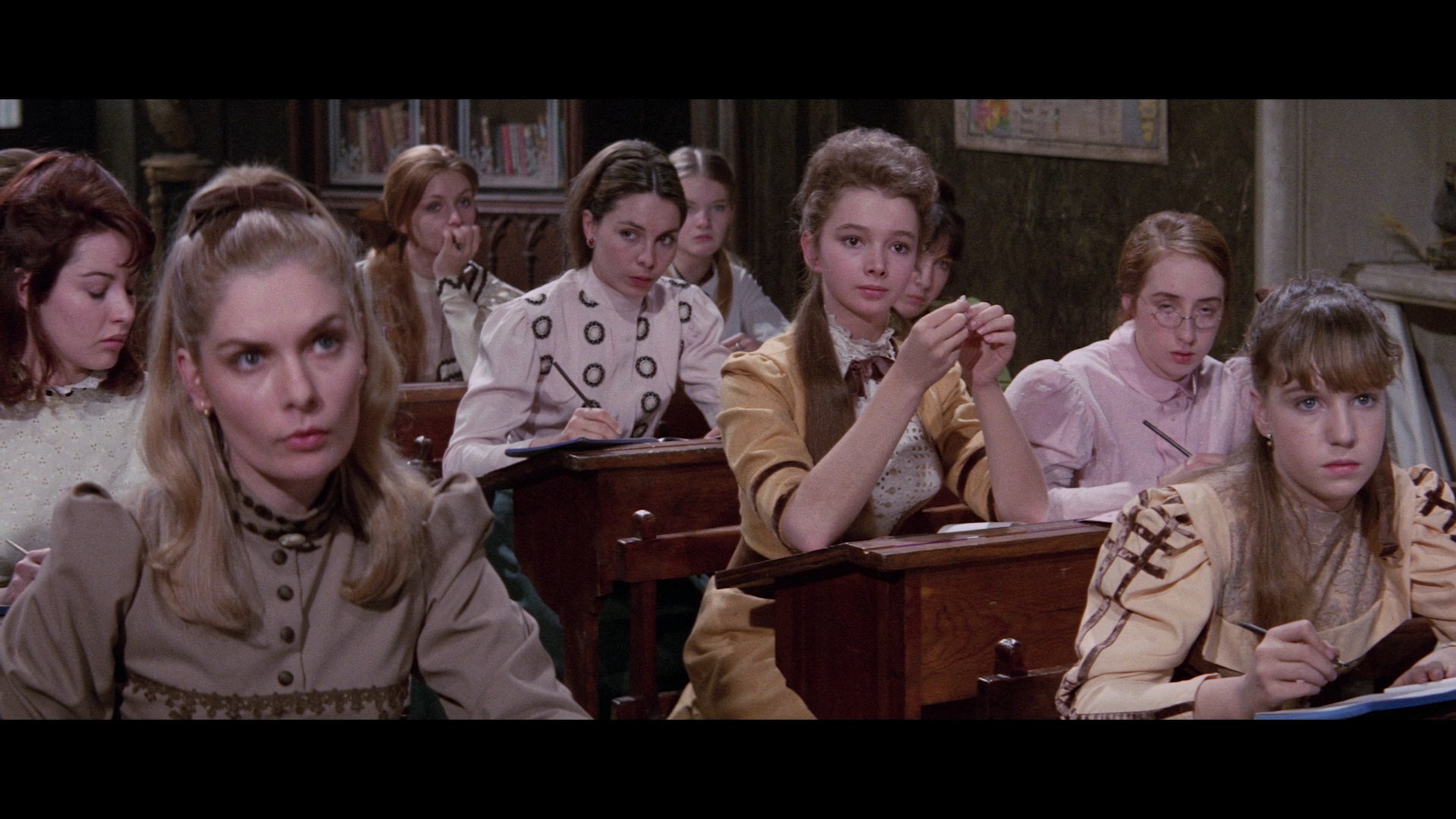 the film with misogyny and termed it "gory," neither of which bear up under close study. The film's only significant male character is a seriously dysfunctional, pubescent prat with a mommy complex; the women run the show here, and while some like Fourneau allow their power to run rampant, others like Irene display a fascinating ability to adapt to their circumstances (and often subvert audience expectations). The deaths in the film are comparatively restrained but exquisitely well-handled using devices like slow motion and freeze frames to shocking effect. The killer's identity is barely concealed and offers little surprise; instead the film focuses on style and atmosphere, with a beautiful score by Waldo De Los Rios to keep the ears occupied as well. A classic all around and one of the essential titles for a full appreciation of European horror.
the film with misogyny and termed it "gory," neither of which bear up under close study. The film's only significant male character is a seriously dysfunctional, pubescent prat with a mommy complex; the women run the show here, and while some like Fourneau allow their power to run rampant, others like Irene display a fascinating ability to adapt to their circumstances (and often subvert audience expectations). The deaths in the film are comparatively restrained but exquisitely well-handled using devices like slow motion and freeze frames to shocking effect. The killer's identity is barely concealed and offers little surprise; instead the film focuses on style and atmosphere, with a beautiful score by Waldo De Los Rios to keep the ears occupied as well. A classic all around and one of the essential titles for a full appreciation of European horror.
Released by AIP as The House that Screamed, this film was shorn of several bloody frames (some vital to the plot) while also tightening the pace in a few spots. The uncut version became a gray market staple, though the essential widescreen framing was destroyed by full frame or compromised 1.85:1 aspect ratios. The flawed but worthwhile Spanish DVD from Divisa was the first to fully restore the anamorphic compositions, essential to savoring the sly wit and crafty visual manipulations of the film. Unfortunately not 16:9 enhanced, the visual appearance is saddled with noticeable flaws including inconsistent black levels and a color scheme which veers a little too close to rust. Audio is presented in Spanish only with no subtitles, in either a worthless 5.1 mix (which mostly shoves the audio to the front two speakers with a few knob-twisting, gimmicky effects thrown to the rears) or the genuine, infinitely preferable mono mix. The same disc was fan subbed for a while, and the limited extras include a still gallery and Serrador filmography.
After that Shout! Factory issued a DVD of the film's presentation as part of Elvira's Movie Macabre, using a fandub as the source for the film itself (and that version is still streaming through various outlets).
In 2016, Scream Factory bowed the film on Blu-ray for the first time featuring the home 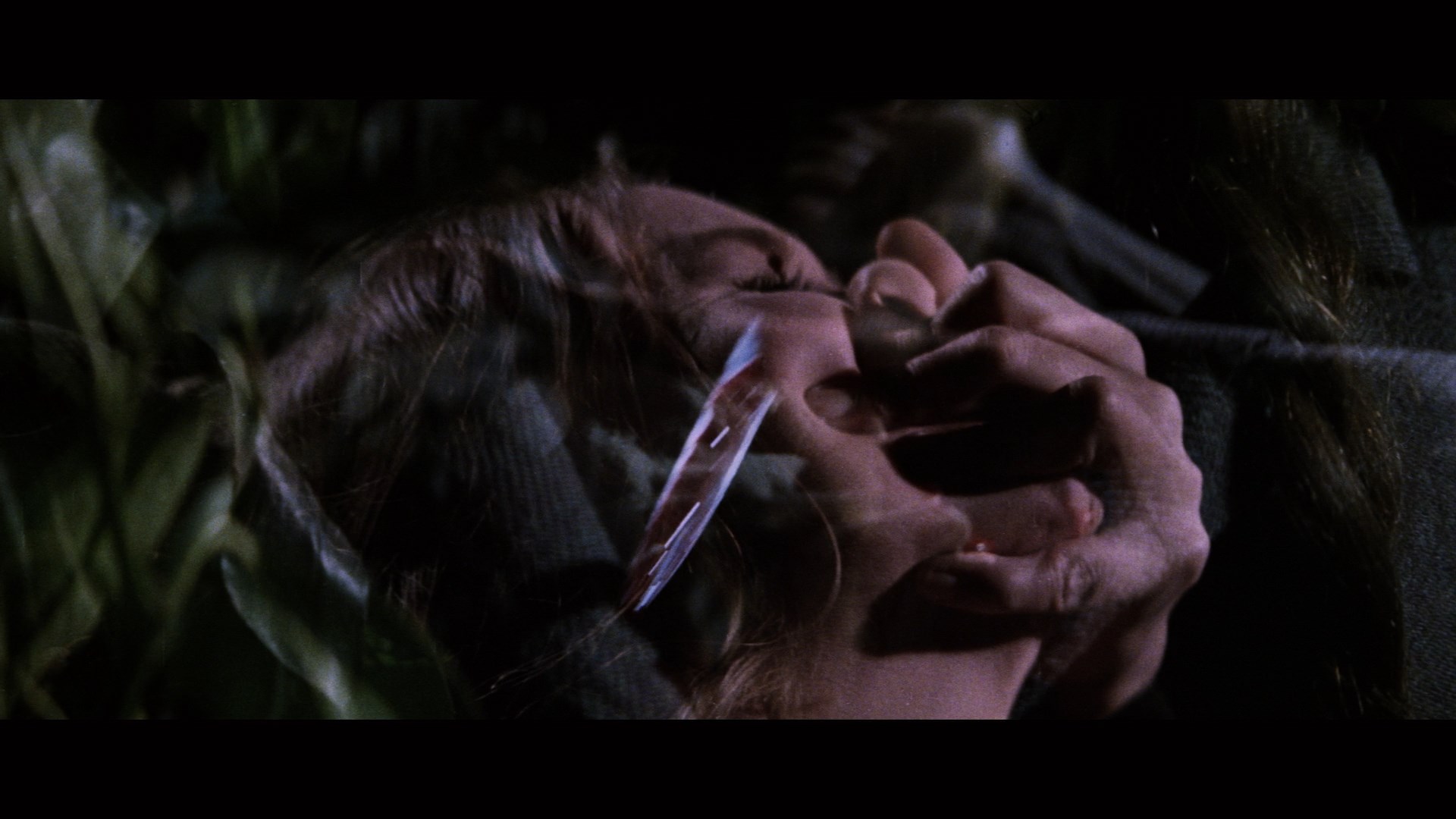 video debut of the U.S. AIP version as well as a composite of the longer 103m45s European cut, using dupey VHS letterboxed inserts throughout. It wasn't an ideal solution, but it was the best we could get at the time and the DTS-HD MA English 2.0 mono track (with optional English SDH subtitles) was fine. Extras included a Munich Film Festival interview from 2011 (6m12s) with Moulder-Brown, a Mary Maude (12m14s)
video debut of the U.S. AIP version as well as a composite of the longer 103m45s European cut, using dupey VHS letterboxed inserts throughout. It wasn't an ideal solution, but it was the best we could get at the time and the DTS-HD MA English 2.0 mono track (with optional English SDH subtitles) was fine. Extras included a Munich Film Festival interview from 2011 (6m12s) with Moulder-Brown, a Mary Maude (12m14s)  interview from the 2012 Festival of Fantastic Films in Manchester, 2m4s of radio spots, a photo gallery, a trailer, and a TV spot. Soon after the German label Alive tried to fix things by offering just the extended cut of the film using film-based material instead of the VHS inserts, but the results were a bit of a mess with the opening credits awkwardly stitched from French and Spanish sources with a great deal of footage missing in the process. Released as Das Versteck and clocking in at 101m28s, it features German, English, Spanish, and Italian audio with German and English subs, plus Brown and Maude interviews and a gallery.
interview from the 2012 Festival of Fantastic Films in Manchester, 2m4s of radio spots, a photo gallery, a trailer, and a TV spot. Soon after the German label Alive tried to fix things by offering just the extended cut of the film using film-based material instead of the VHS inserts, but the results were a bit of a mess with the opening credits awkwardly stitched from French and Spanish sources with a great deal of footage missing in the process. Released as Das Versteck and clocking in at 101m28s, it features German, English, Spanish, and Italian audio with German and English subs, plus Brown and Maude interviews and a gallery.
In 2023, Arrow Video finally stepped in with what has to be considered a miracle in the history of European horror on home video: a truly uncut, excellent quality restoration of the film with all of its footage sourced from fine quality film elements. They don't go into specifics but the presentation is a massive leap forward, with previously troublesome passages like the main titles (here as The Finishing School) 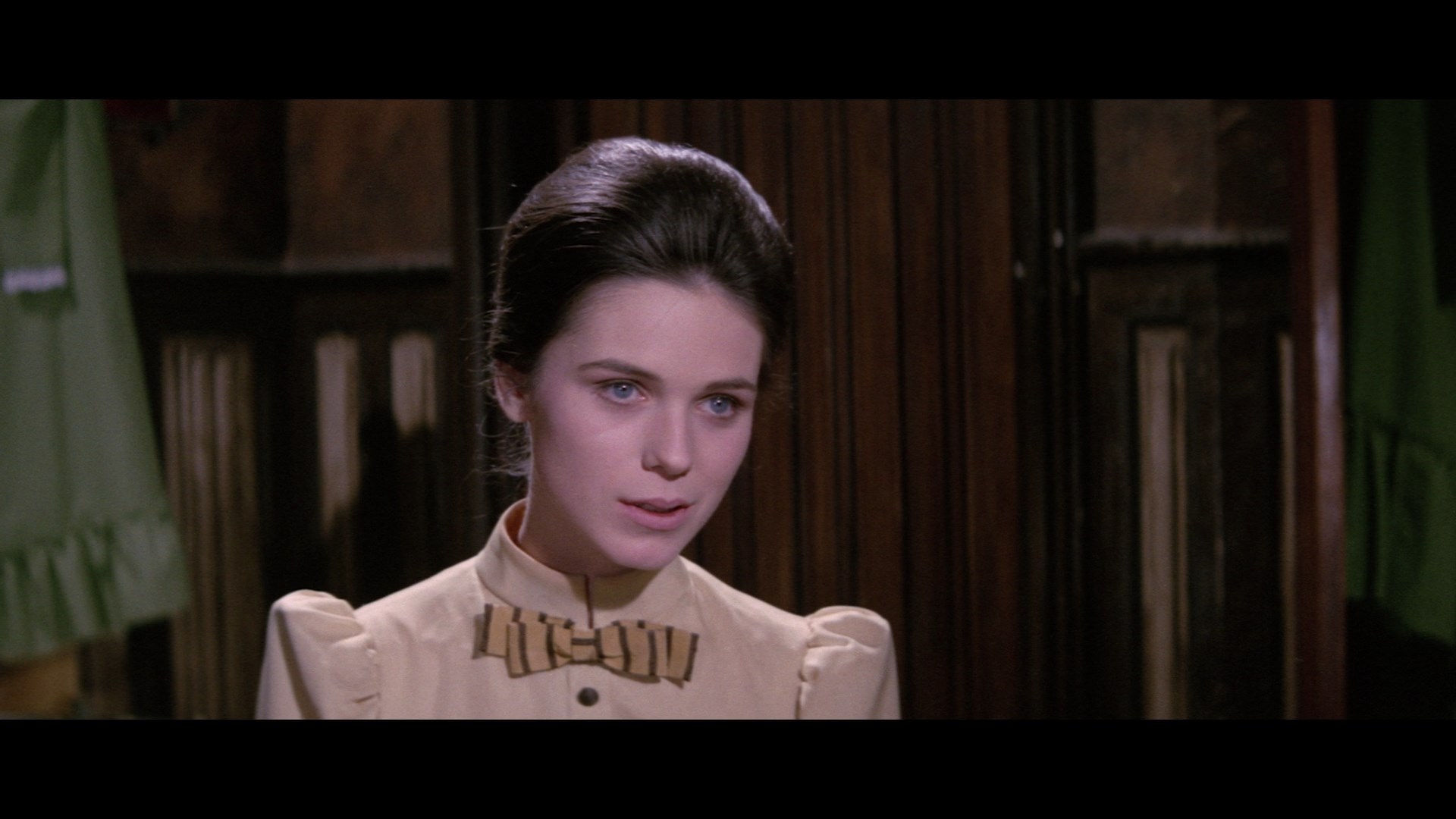 and the murder scenes now looking pristine at last (with more image info visible to boot). The color scheme is also more varied and delicate than the very brown look of past releases. The English and Spanish mono tracks are included as 1.0 LPCM with English SDH or translated subtitles depending on which version you choose. Via seamless branching you can also watch the shorter AIP version complete with the U.S. credits and opening logo, with obviously identical quality.
and the murder scenes now looking pristine at last (with more image info visible to boot). The color scheme is also more varied and delicate than the very brown look of past releases. The English and Spanish mono tracks are included as 1.0 LPCM with English SDH or translated subtitles depending on which version you choose. Via seamless branching you can also watch the shorter AIP version complete with the U.S. credits and opening logo, with obviously identical quality.
 An excellent new audio commentary by Anna Bogutskaya over the full-length cut is recommended listening as she uses her own Spanish background to discuss Serrador's importance on the genre, the cultural climate in Spain at the time, the representation of the period setting, and the various players behind the scenes as well as the development of the story and the film's release history. "This Boy’s Innocence" (24m20s) is a previously unreleased interview with Moulder-Brown presented by Fiction Factory, noting how he approached the psychological aspects of the character, how he felt at the time starting to transition from child actor roles, and what he observed in this early attempt by Spanish cinema to go truly global outside the art film circuit. The Mary Maude interview from the past two Blu-rays is carried over here as well, followed by "All About My 'Mama'" (9m25s) with Juan Tébar, author of the original story, explaining how the various elements involving repressions, murder mystery, and tyranny coalesced together as well as some of the influences like Dickens and Hitchcock he incorporated. "The Legacy of Terror" (13m55s) features the director’s son, Alejandro Ibáñez, explaining how his father essentially set the stage for mainstream Spanish horror with his TV and film work, with other significant filmmakers following in his footsteps in Spain. The director is covered even more in "Screaming the House Down" (20m23s) with Dr. Antonio Lázaro-Reboll exploring how TV familiarity made the filmmaker such a household name that the production could carry more cachet than usual for the industry at the time. A 6m9s reel of SD footage from the Spanish version culled from various VHS and DVD releases covers some alternate shots involving written text or toned-down takes for local audiences, followed by the U.S. trailer, two TV spots, two radio spots, and a gallery of 35 B&W photos. The reversible sleeve art comes with the original poster art and a new design by Colin Murdoch, while the first pressing also has an insert booklet with an essay by Shelagh Rowan-Legg and a double-sided fold-out poster.
An excellent new audio commentary by Anna Bogutskaya over the full-length cut is recommended listening as she uses her own Spanish background to discuss Serrador's importance on the genre, the cultural climate in Spain at the time, the representation of the period setting, and the various players behind the scenes as well as the development of the story and the film's release history. "This Boy’s Innocence" (24m20s) is a previously unreleased interview with Moulder-Brown presented by Fiction Factory, noting how he approached the psychological aspects of the character, how he felt at the time starting to transition from child actor roles, and what he observed in this early attempt by Spanish cinema to go truly global outside the art film circuit. The Mary Maude interview from the past two Blu-rays is carried over here as well, followed by "All About My 'Mama'" (9m25s) with Juan Tébar, author of the original story, explaining how the various elements involving repressions, murder mystery, and tyranny coalesced together as well as some of the influences like Dickens and Hitchcock he incorporated. "The Legacy of Terror" (13m55s) features the director’s son, Alejandro Ibáñez, explaining how his father essentially set the stage for mainstream Spanish horror with his TV and film work, with other significant filmmakers following in his footsteps in Spain. The director is covered even more in "Screaming the House Down" (20m23s) with Dr. Antonio Lázaro-Reboll exploring how TV familiarity made the filmmaker such a household name that the production could carry more cachet than usual for the industry at the time. A 6m9s reel of SD footage from the Spanish version culled from various VHS and DVD releases covers some alternate shots involving written text or toned-down takes for local audiences, followed by the U.S. trailer, two TV spots, two radio spots, and a gallery of 35 B&W photos. The reversible sleeve art comes with the original poster art and a new design by Colin Murdoch, while the first pressing also has an insert booklet with an essay by Shelagh Rowan-Legg and a double-sided fold-out poster.
Arrow Video (Blu-ray)
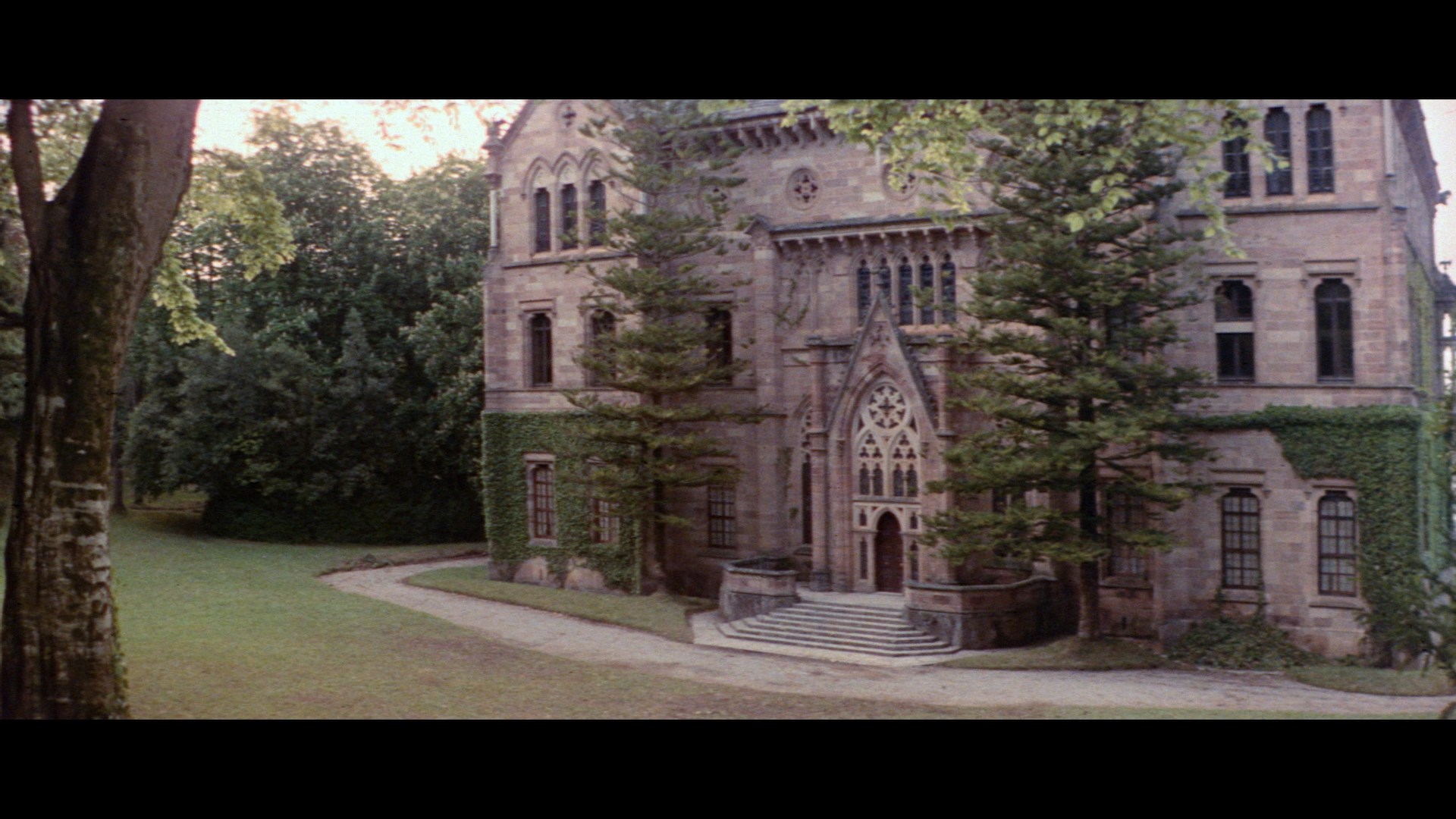
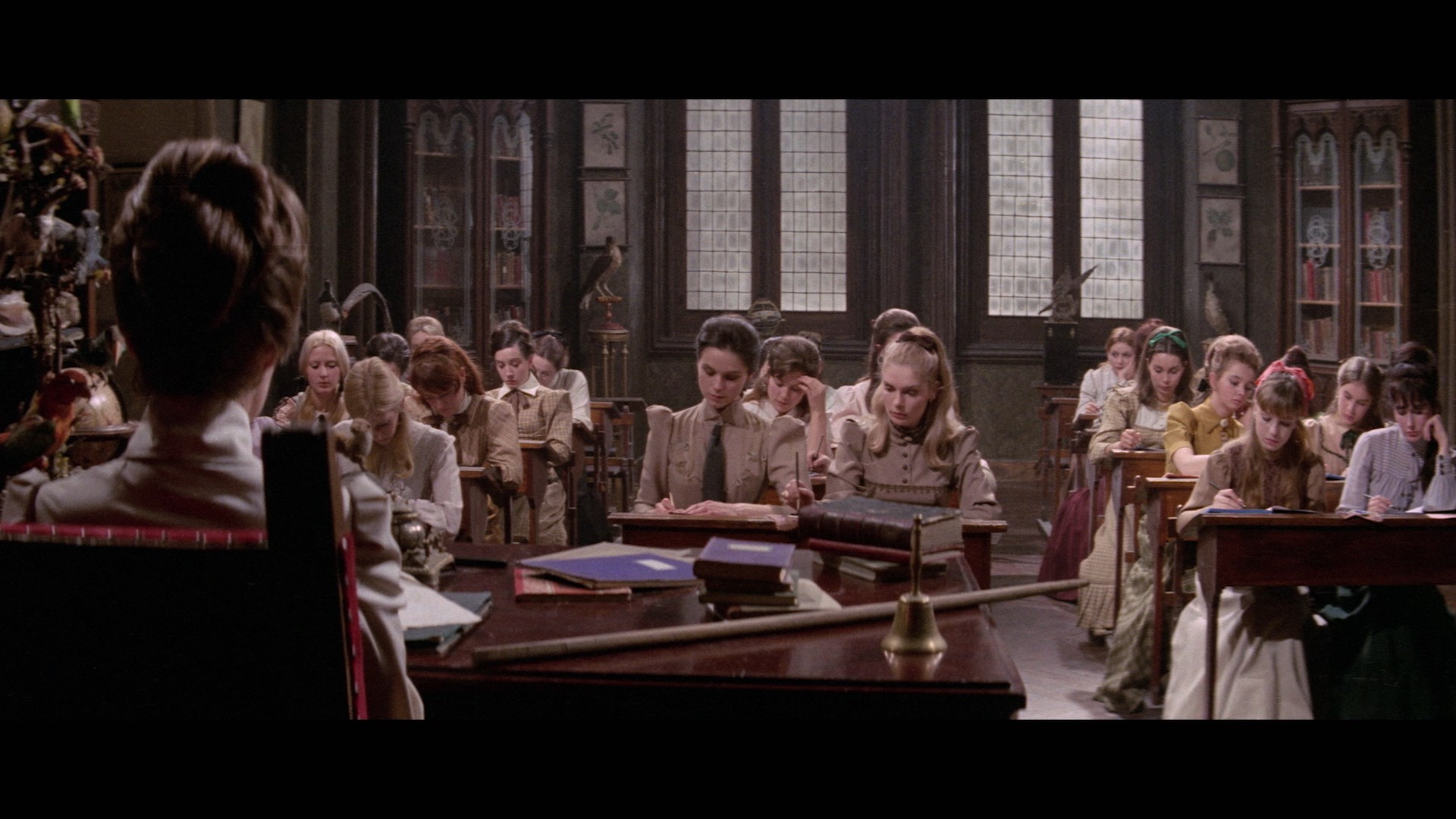
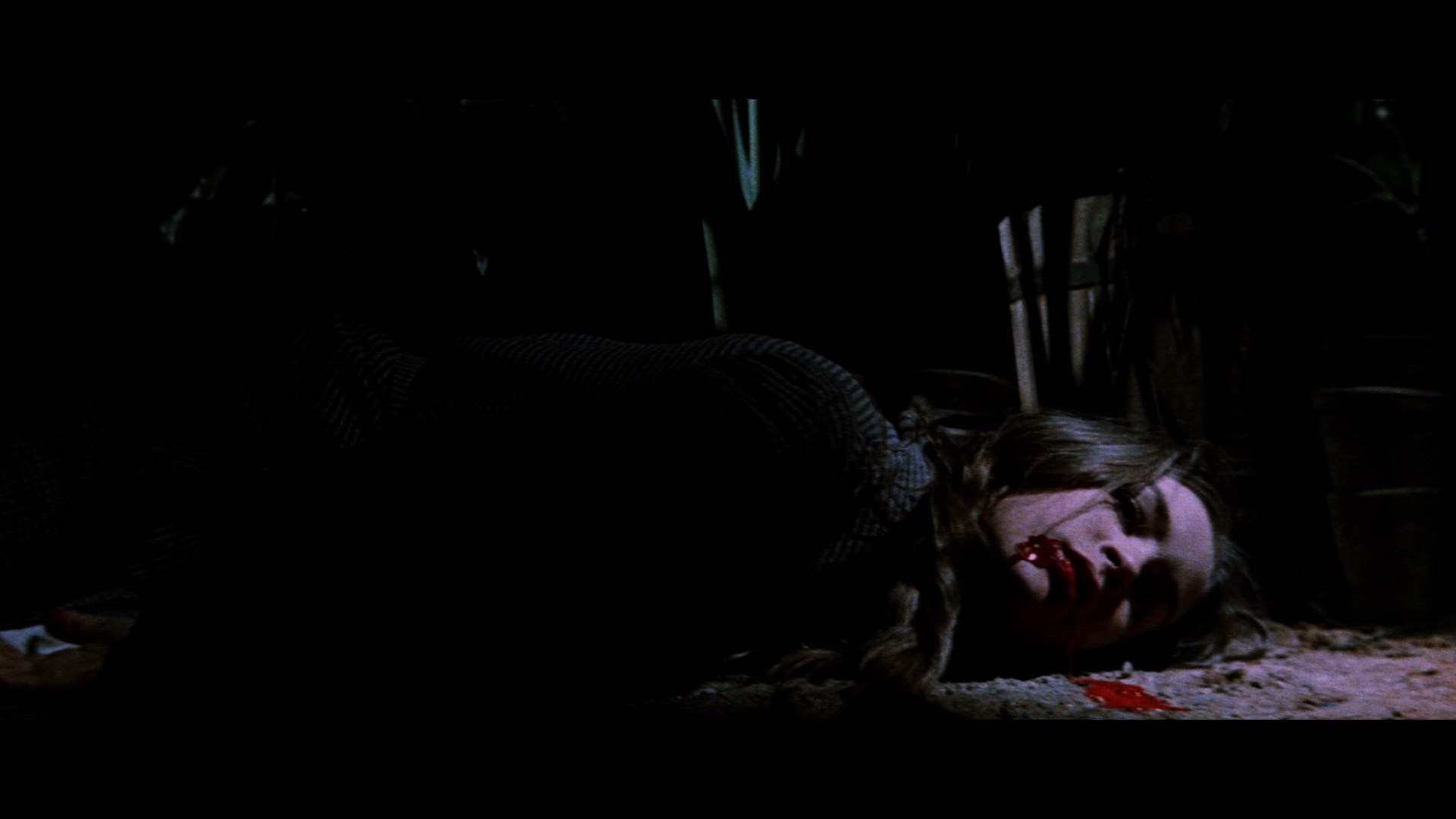
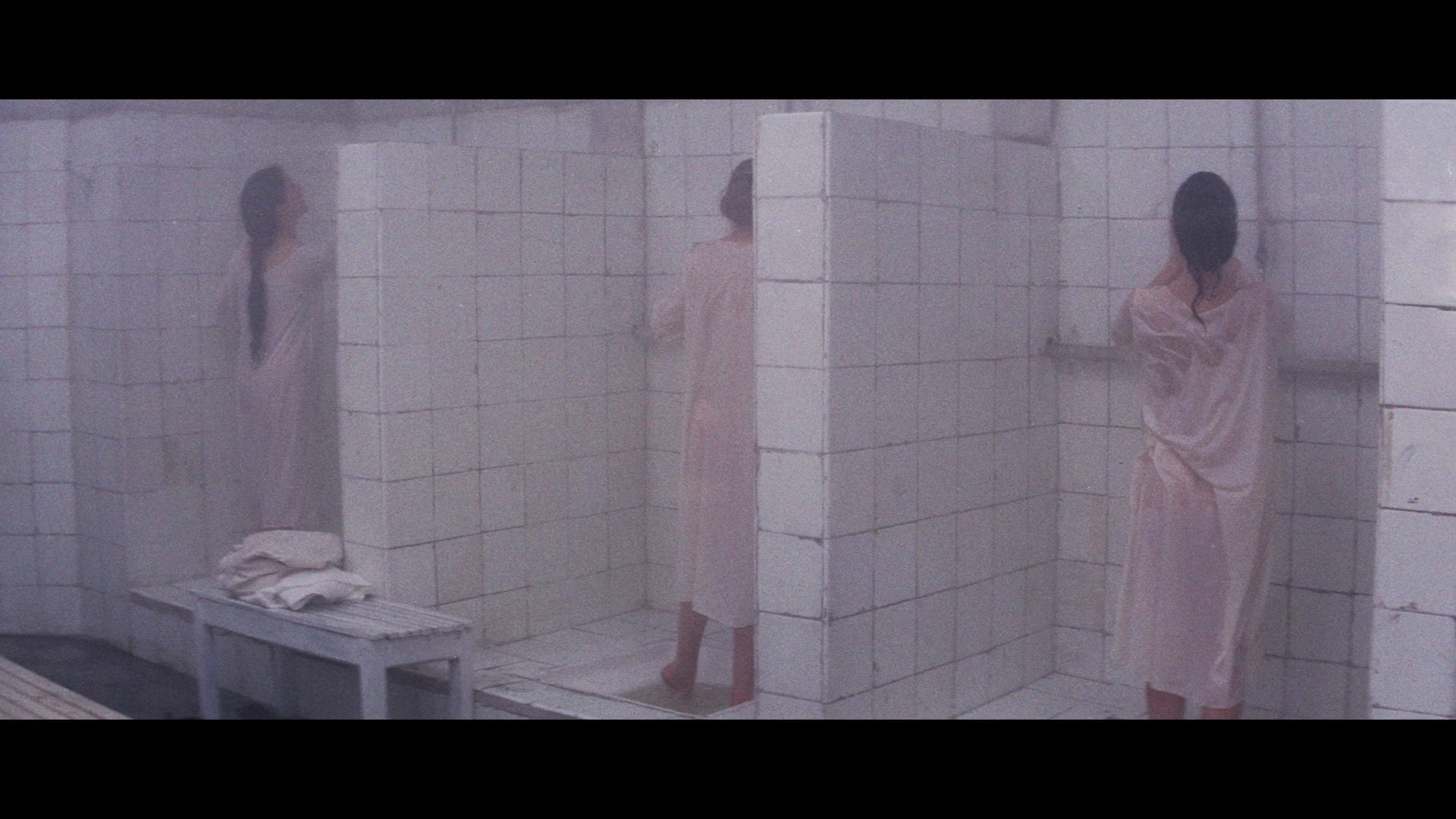
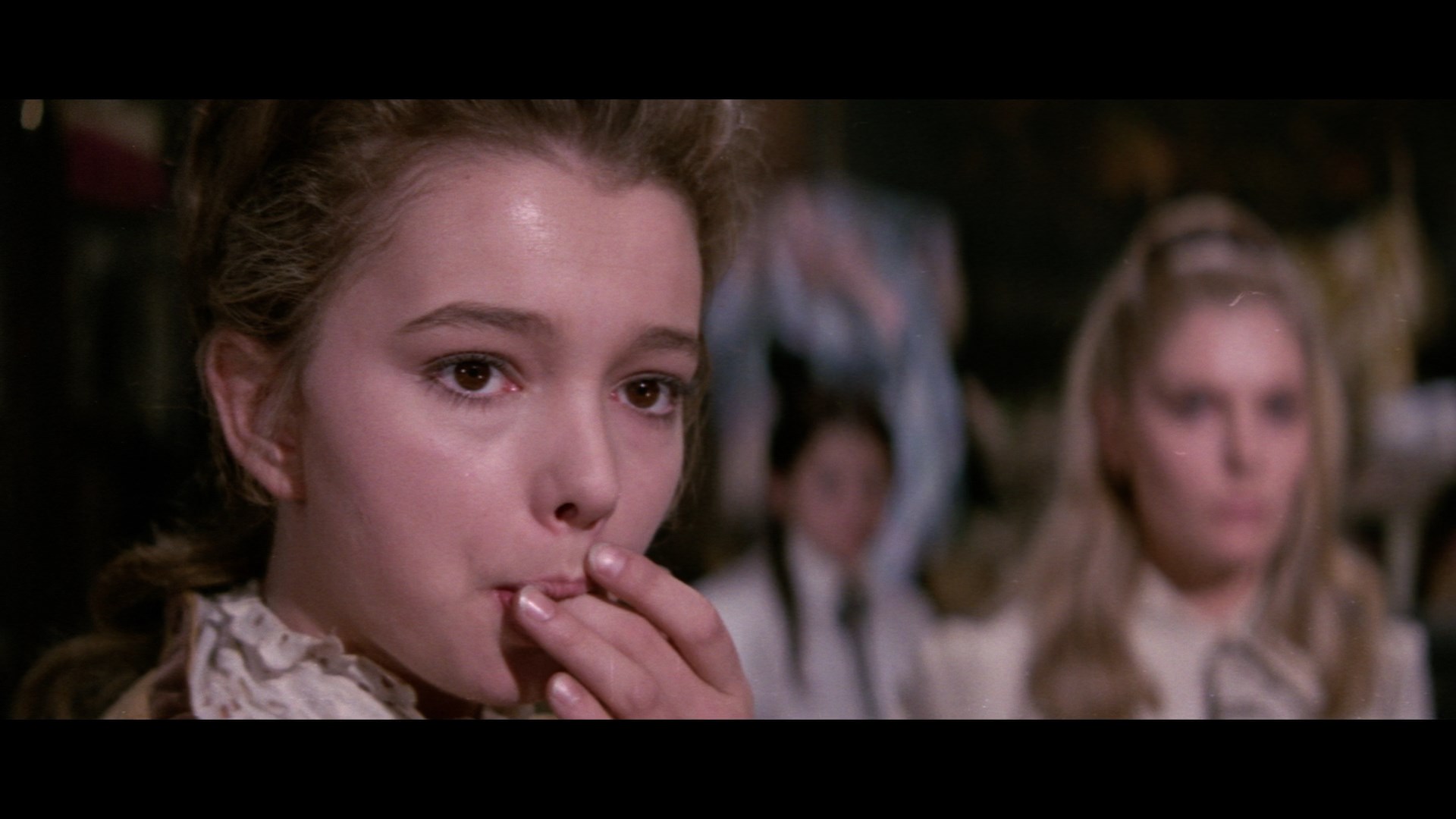
Scream Factory (Blu-ray)
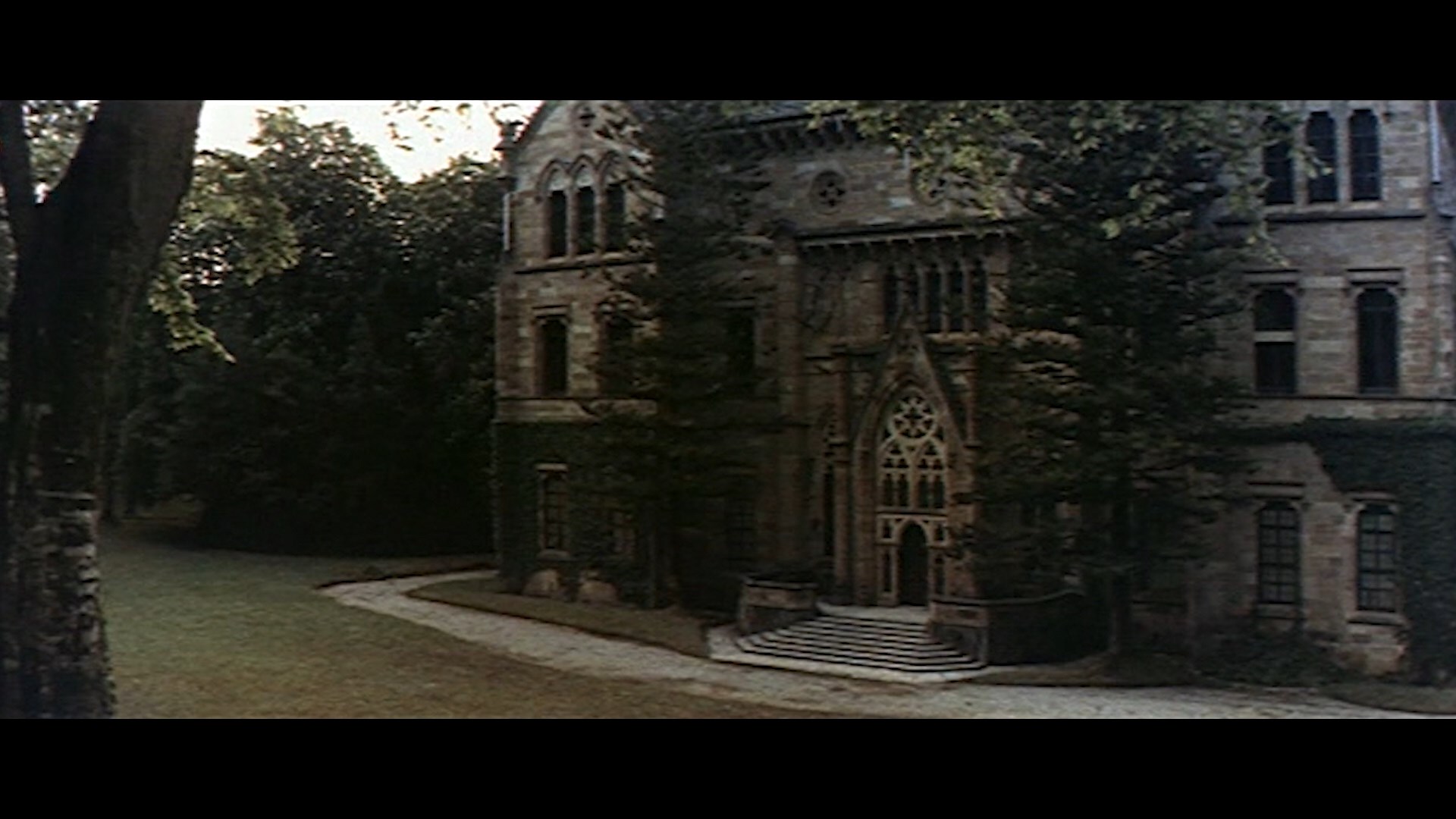
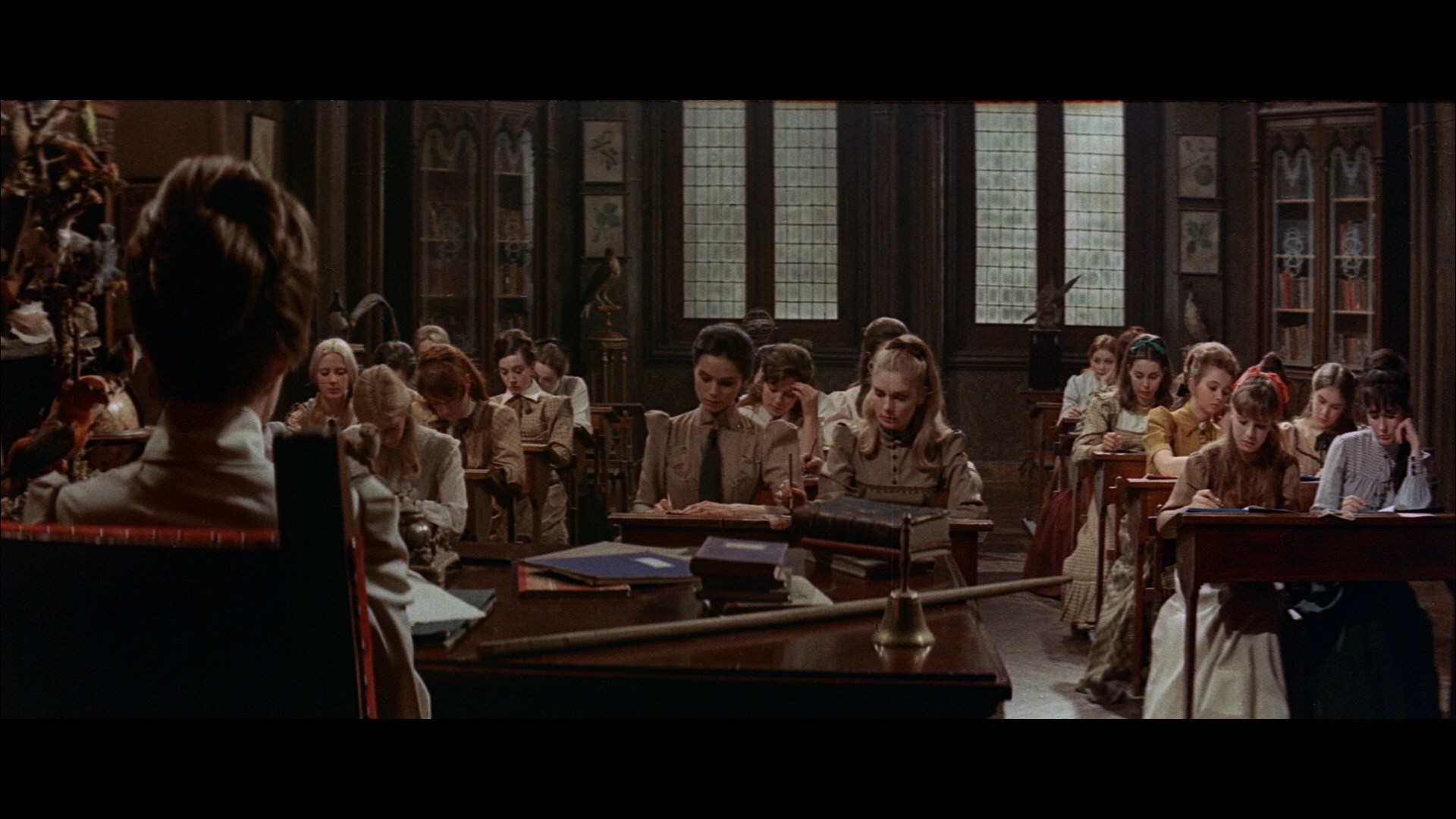
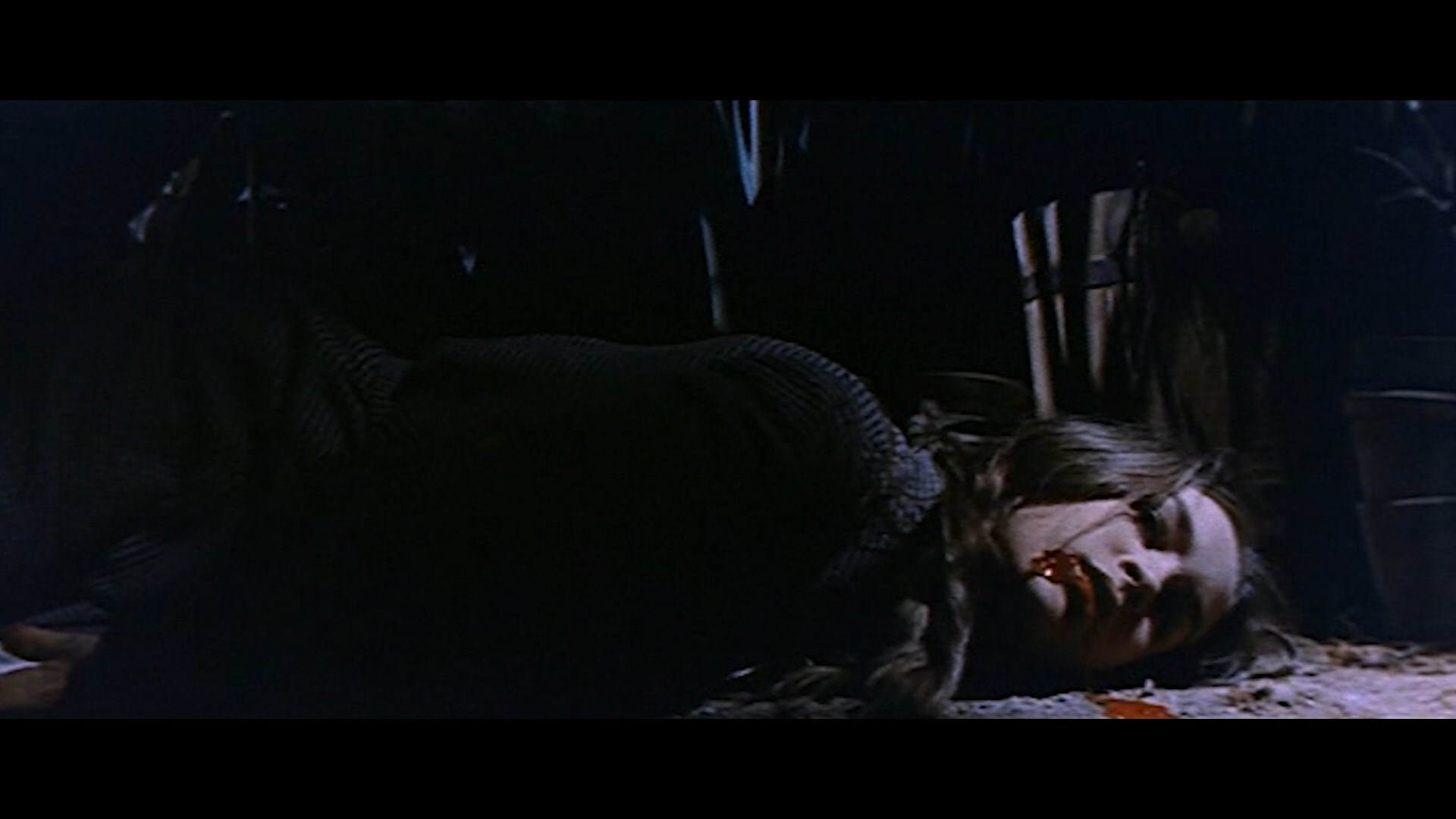
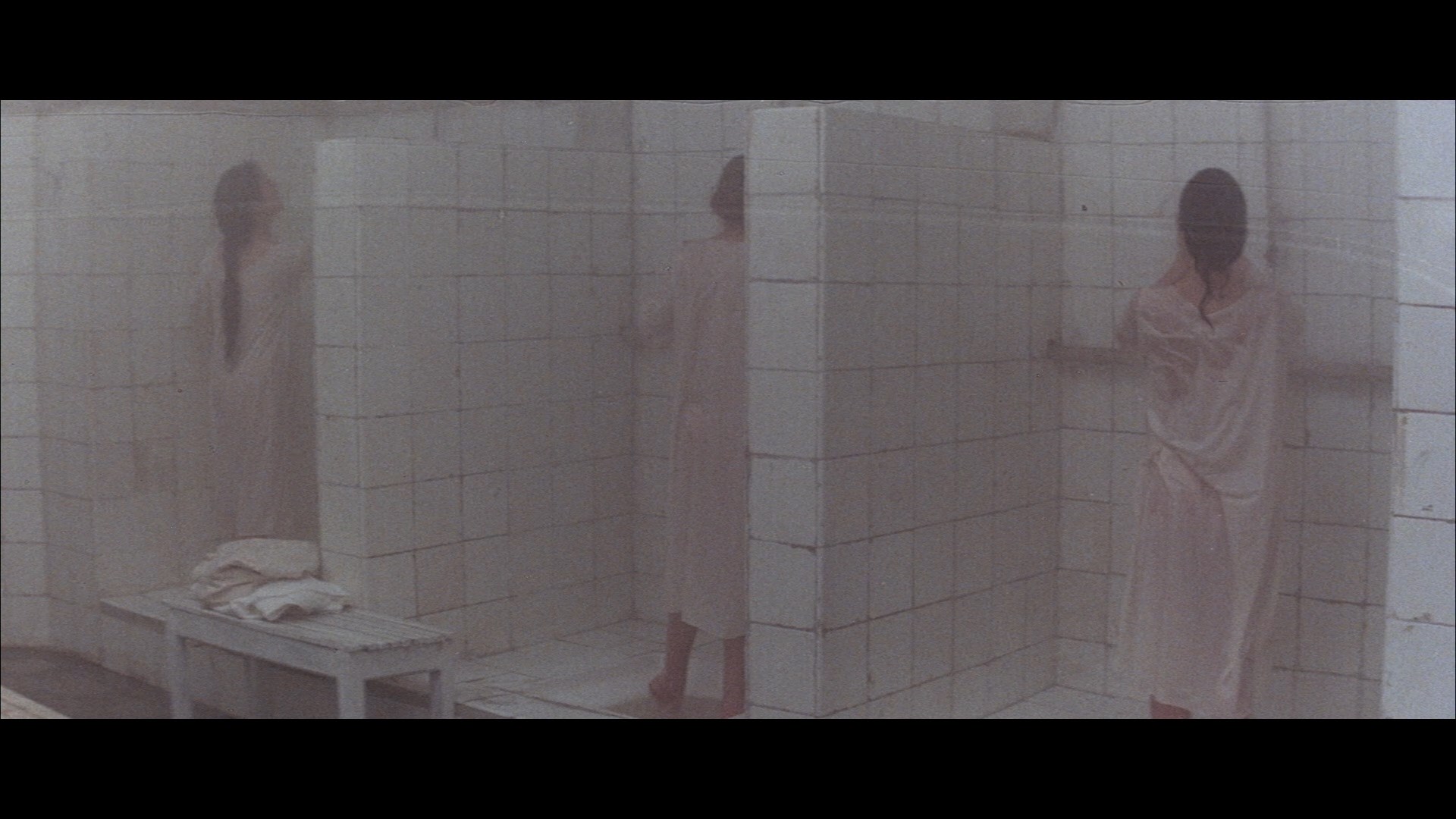
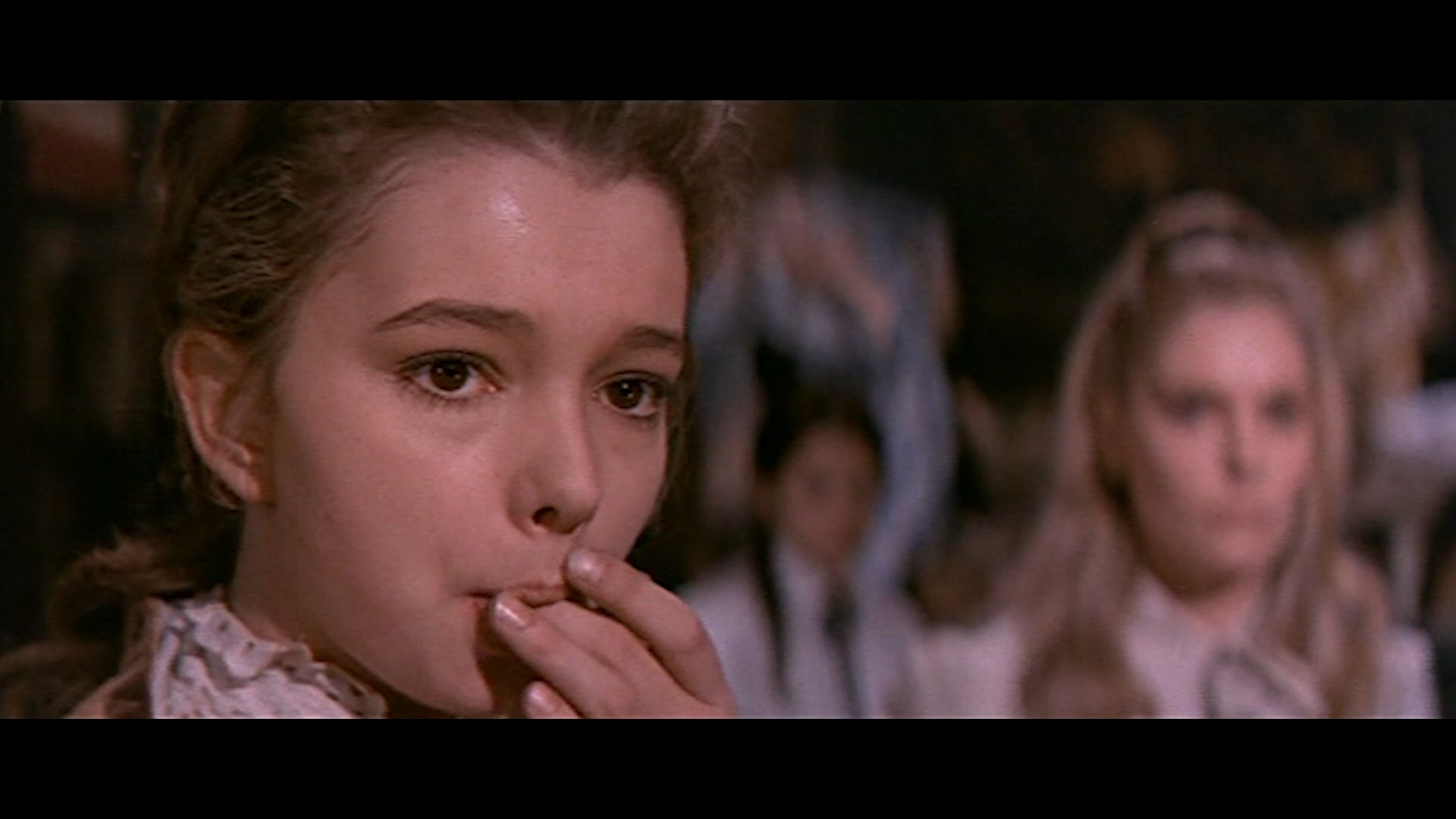
Alive (Blu-ray)
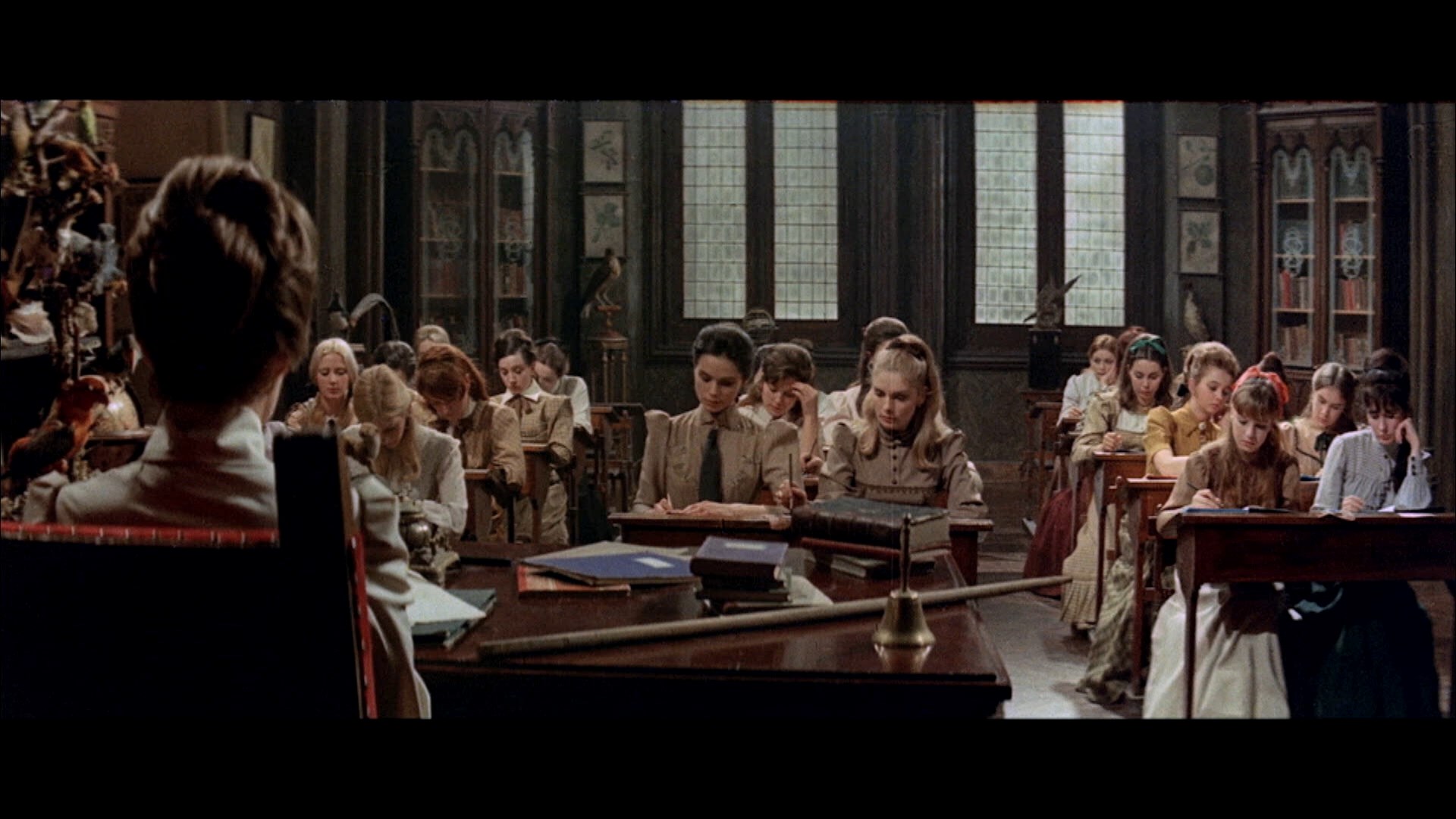



Updated review on February 12, 2023.



 saw the revitalization of the giallo courtesy of Dario Argento's first
saw the revitalization of the giallo courtesy of Dario Argento's first  film, The Bird with the Crystal Plumage, Spain was jumping into the game with its own Gothic twist on the same themes, Narciso "Chicho" Ibáñez Serrador's La residencia, a film that would in turn be cited as a major influence on Argento's Suspiria. Both films received notable wide releases abroad (edited down to receive lenient GP ratings in America), but Serrador, already famous in Spain for his ongoing TV series Tales to Keep You Awake, only returned to the genre once more with the excellent Quién puede matar a un niño? (Who Can Kill a Child?), released by AIP as Island of the Damned.
film, The Bird with the Crystal Plumage, Spain was jumping into the game with its own Gothic twist on the same themes, Narciso "Chicho" Ibáñez Serrador's La residencia, a film that would in turn be cited as a major influence on Argento's Suspiria. Both films received notable wide releases abroad (edited down to receive lenient GP ratings in America), but Serrador, already famous in Spain for his ongoing TV series Tales to Keep You Awake, only returned to the genre once more with the excellent Quién puede matar a un niño? (Who Can Kill a Child?), released by AIP as Island of the Damned.
 of the baroque settings, often filing the girls across the screen with each one's expression perfectly conveying where she lies in the academic food chain. Several critics, most notably Phil Hardy's Aurum Encyclopedia, charged
of the baroque settings, often filing the girls across the screen with each one's expression perfectly conveying where she lies in the academic food chain. Several critics, most notably Phil Hardy's Aurum Encyclopedia, charged  the film with misogyny and termed it "gory," neither of which bear up under close study. The film's only significant male character is a seriously dysfunctional, pubescent prat with a mommy complex; the women run the show here, and while some like Fourneau allow their power to run rampant, others like Irene display a fascinating ability to adapt to their circumstances (and often subvert audience expectations). The deaths in the film are comparatively restrained but exquisitely well-handled using devices like slow motion and freeze frames to shocking effect. The killer's identity is barely concealed and offers little surprise; instead the film focuses on style and atmosphere, with a beautiful score by Waldo De Los Rios to keep the ears occupied as well. A classic all around and one of the essential titles for a full appreciation of European horror.
the film with misogyny and termed it "gory," neither of which bear up under close study. The film's only significant male character is a seriously dysfunctional, pubescent prat with a mommy complex; the women run the show here, and while some like Fourneau allow their power to run rampant, others like Irene display a fascinating ability to adapt to their circumstances (and often subvert audience expectations). The deaths in the film are comparatively restrained but exquisitely well-handled using devices like slow motion and freeze frames to shocking effect. The killer's identity is barely concealed and offers little surprise; instead the film focuses on style and atmosphere, with a beautiful score by Waldo De Los Rios to keep the ears occupied as well. A classic all around and one of the essential titles for a full appreciation of European horror.  video debut of the U.S. AIP version as well as a composite of the longer 103m45s European cut, using dupey VHS letterboxed inserts throughout. It wasn't an ideal solution, but it was the best we could get at the time and the DTS-HD MA English 2.0 mono track (with optional English SDH subtitles) was fine. Extras included a Munich Film Festival interview from 2011 (6m12s) with Moulder-Brown, a Mary Maude (12m14s)
video debut of the U.S. AIP version as well as a composite of the longer 103m45s European cut, using dupey VHS letterboxed inserts throughout. It wasn't an ideal solution, but it was the best we could get at the time and the DTS-HD MA English 2.0 mono track (with optional English SDH subtitles) was fine. Extras included a Munich Film Festival interview from 2011 (6m12s) with Moulder-Brown, a Mary Maude (12m14s)  interview from the 2012 Festival of Fantastic Films in Manchester, 2m4s of radio spots, a photo gallery, a trailer, and a TV spot. Soon after the German label Alive tried to fix things by offering just the extended cut of the film using film-based material instead of the VHS inserts, but the results were a bit of a mess with the opening credits awkwardly stitched from French and Spanish sources with a great deal of footage missing in the process. Released as Das Versteck and clocking in at 101m28s, it features German, English, Spanish, and Italian audio with German and English subs, plus Brown and Maude interviews and a gallery.
interview from the 2012 Festival of Fantastic Films in Manchester, 2m4s of radio spots, a photo gallery, a trailer, and a TV spot. Soon after the German label Alive tried to fix things by offering just the extended cut of the film using film-based material instead of the VHS inserts, but the results were a bit of a mess with the opening credits awkwardly stitched from French and Spanish sources with a great deal of footage missing in the process. Released as Das Versteck and clocking in at 101m28s, it features German, English, Spanish, and Italian audio with German and English subs, plus Brown and Maude interviews and a gallery. and the murder scenes now looking pristine at last (with more image info visible to boot). The color scheme is also more varied and delicate than the very brown look of past releases. The English and Spanish mono tracks are included as 1.0 LPCM with English SDH or translated subtitles depending on which version you choose. Via seamless branching you can also watch the shorter AIP version complete with the U.S. credits and opening logo, with obviously identical quality.
and the murder scenes now looking pristine at last (with more image info visible to boot). The color scheme is also more varied and delicate than the very brown look of past releases. The English and Spanish mono tracks are included as 1.0 LPCM with English SDH or translated subtitles depending on which version you choose. Via seamless branching you can also watch the shorter AIP version complete with the U.S. credits and opening logo, with obviously identical quality. An excellent new audio commentary by Anna Bogutskaya over the full-length cut is recommended listening as she uses her own Spanish background to discuss Serrador's importance on the genre, the cultural climate in Spain at the time, the representation of the period setting, and the various players behind the scenes as well as the development of the story and the film's release history. "This Boy’s Innocence" (24m20s) is a previously unreleased interview with Moulder-Brown presented by Fiction Factory, noting how he approached the psychological aspects of the character, how he felt at the time starting to transition from child actor roles, and what he observed in this early attempt by Spanish cinema to go truly global outside the art film circuit. The Mary Maude interview from the past two Blu-rays is carried over here as well, followed by "All About My 'Mama'" (9m25s) with Juan Tébar, author of the original story, explaining how the various elements involving repressions, murder mystery, and tyranny coalesced together as well as some of the influences like Dickens and Hitchcock he incorporated. "The Legacy of Terror" (13m55s) features the director’s son, Alejandro Ibáñez, explaining how his father essentially set the stage for mainstream Spanish horror with his TV and film work, with other significant filmmakers following in his footsteps in Spain. The director is covered even more in "Screaming the House Down" (20m23s) with Dr. Antonio Lázaro-Reboll exploring how TV familiarity made the filmmaker such a household name that the production could carry more cachet than usual for the industry at the time. A 6m9s reel of SD footage from the Spanish version culled from various VHS and DVD releases covers some alternate shots involving written text or toned-down takes for local audiences, followed by the U.S. trailer, two TV spots, two radio spots, and a gallery of 35 B&W photos. The reversible sleeve art comes with the original poster art and a new design by Colin Murdoch, while the first pressing also has an insert booklet with an essay by Shelagh Rowan-Legg and a double-sided fold-out poster.
An excellent new audio commentary by Anna Bogutskaya over the full-length cut is recommended listening as she uses her own Spanish background to discuss Serrador's importance on the genre, the cultural climate in Spain at the time, the representation of the period setting, and the various players behind the scenes as well as the development of the story and the film's release history. "This Boy’s Innocence" (24m20s) is a previously unreleased interview with Moulder-Brown presented by Fiction Factory, noting how he approached the psychological aspects of the character, how he felt at the time starting to transition from child actor roles, and what he observed in this early attempt by Spanish cinema to go truly global outside the art film circuit. The Mary Maude interview from the past two Blu-rays is carried over here as well, followed by "All About My 'Mama'" (9m25s) with Juan Tébar, author of the original story, explaining how the various elements involving repressions, murder mystery, and tyranny coalesced together as well as some of the influences like Dickens and Hitchcock he incorporated. "The Legacy of Terror" (13m55s) features the director’s son, Alejandro Ibáñez, explaining how his father essentially set the stage for mainstream Spanish horror with his TV and film work, with other significant filmmakers following in his footsteps in Spain. The director is covered even more in "Screaming the House Down" (20m23s) with Dr. Antonio Lázaro-Reboll exploring how TV familiarity made the filmmaker such a household name that the production could carry more cachet than usual for the industry at the time. A 6m9s reel of SD footage from the Spanish version culled from various VHS and DVD releases covers some alternate shots involving written text or toned-down takes for local audiences, followed by the U.S. trailer, two TV spots, two radio spots, and a gallery of 35 B&W photos. The reversible sleeve art comes with the original poster art and a new design by Colin Murdoch, while the first pressing also has an insert booklet with an essay by Shelagh Rowan-Legg and a double-sided fold-out poster.












